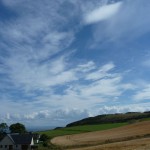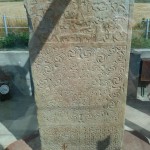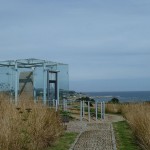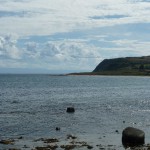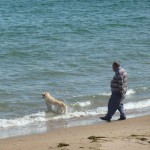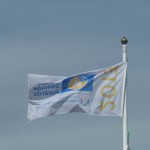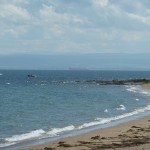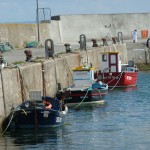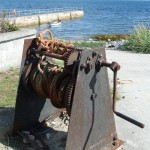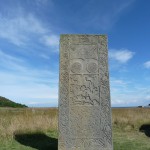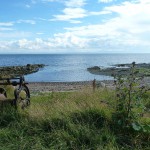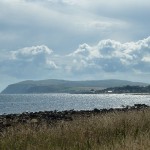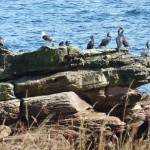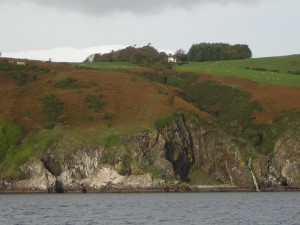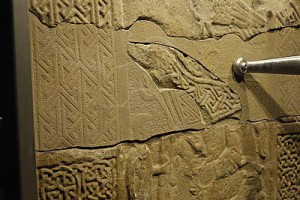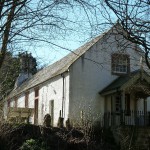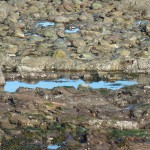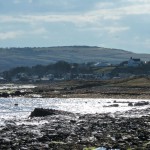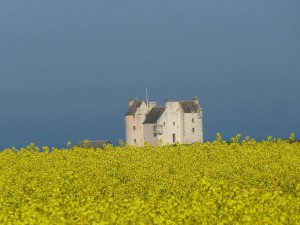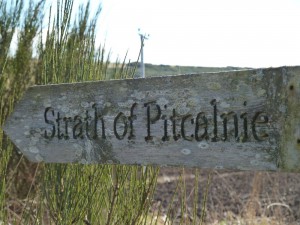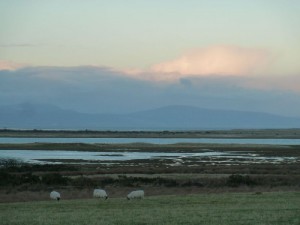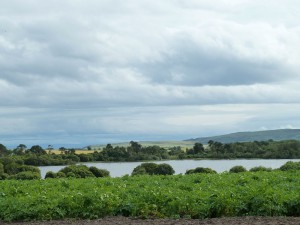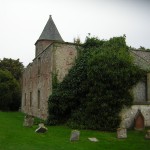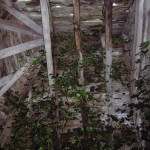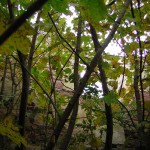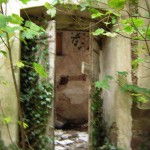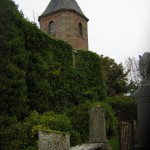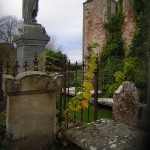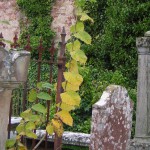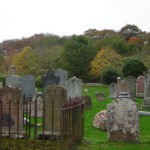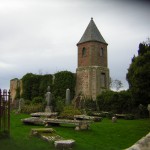Browsing Posts published by seaboardgàidhlig
2013 an t-Iuchar: Ainmean-àite 5 – Beurla is Beurla Ghallda / July: Placenames 5 – English and Scots
Ainmean-àite 5 – Beurla agus Beurla Ghallda
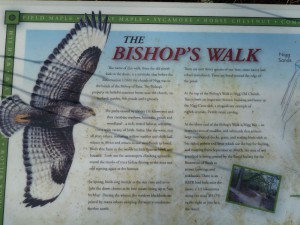 Mar a chunnaic sinn mar-thà, ‘s e eachdraidh fhada agus gu ìre chaochlaideach a bha aig Machair Rois. Ach tha aon rud ann a bha seasmhach: bha an-còmhnaidh ùidh mhòr aig luchd-riaghlaidh na h-eaglaise agus na stàite anns an dùthaich thorraich fhasgaich aig ceann Linne Mhoireibh. Bha cudromachd ro-innleachdail aig an làrach seo – dh’fheumadh feadhainn a bha a’ strì airson cumhachd poilitigiche, armailtiche, eaconamiche no cràbhaiche air a’ Ghàidhealtachd, air tìr no air muir, bunait a stèidheachadh an sin. Thàinig na daoine seo – rìghrean, uaislean, easbaigean, seanailearan, marsantan – no na riochdairean aca, gu tric à ceann a deas na h-Alba (no fiù ‘s na b’ fhaide air falbh) agus ri ùine thàinig Beurla Gallda no Beurla còmhla riutha.
Mar a chunnaic sinn mar-thà, ‘s e eachdraidh fhada agus gu ìre chaochlaideach a bha aig Machair Rois. Ach tha aon rud ann a bha seasmhach: bha an-còmhnaidh ùidh mhòr aig luchd-riaghlaidh na h-eaglaise agus na stàite anns an dùthaich thorraich fhasgaich aig ceann Linne Mhoireibh. Bha cudromachd ro-innleachdail aig an làrach seo – dh’fheumadh feadhainn a bha a’ strì airson cumhachd poilitigiche, armailtiche, eaconamiche no cràbhaiche air a’ Ghàidhealtachd, air tìr no air muir, bunait a stèidheachadh an sin. Thàinig na daoine seo – rìghrean, uaislean, easbaigean, seanailearan, marsantan – no na riochdairean aca, gu tric à ceann a deas na h-Alba (no fiù ‘s na b’ fhaide air falbh) agus ri ùine thàinig Beurla Gallda no Beurla còmhla riutha.
Chì sinn air na seann mhapaichean (Pont, Blaeu ammsa) gu bheil mòran chruthan Beurla aig ainmean-àite far an robh cruth Gàidhlig aig muinntir na sgìre: Abbotshaven seach Port an Ab, Hilton seach Baile a’ Chnuic, Castle Tarbat seach Caisteal Baile an Lòin (Ballone), agus ri ùine nochdaidh eiseimpleiren ùra air na mapaichean: Mounteagle seach Cnoc na h-Iolaire, Broomton seach Baile a’ Bhealaidh, agus -fields gun chrìoch. Fhuair na sgrìobhadairean-mapa fios bho dhaoine ‘cudromach’ an àite, nach robh gu trice às an sgìre fhèin, fiù ‘s nam b’ e daoine foghlaimte agus fiosrachail a bh’ annta – ministearan, luchd-teagaisg, fir-lagha amsaa. ‘S dòcha gun robh iad den bheachd gur e ainmean ‘nas fheàrr’, nas fheumaile no fiù ‘s nas sìobhailichte a bh’ anns na h-eadar-theangaidhean seo, agus ri ùine bhiodh cuid de mhuinntir na sgìre a’ creidsinn seo cuideachd, agus iad a’ cleachdadh Beurla co-dhiù airson ghnothaichean na b’ fhoirmeile.
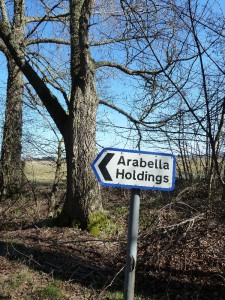 Thug luchd na Beurla seo, no in-imrichean saidhbhreachail as an dèidh (no uaislean ionadail ‘Beurlaichte’), ainmean le brìgh phearsanta air na dachaighean agus oighreachdan aca cuideachd: Brucefield seach Cnoc an Tighearna, Arabella seach Am Bog, Ankerville seach Cinn-dèis (Kindeace), Petley, Kimberley, amssa.
Thug luchd na Beurla seo, no in-imrichean saidhbhreachail as an dèidh (no uaislean ionadail ‘Beurlaichte’), ainmean le brìgh phearsanta air na dachaighean agus oighreachdan aca cuideachd: Brucefield seach Cnoc an Tighearna, Arabella seach Am Bog, Ankerville seach Cinn-dèis (Kindeace), Petley, Kimberley, amssa.
Ach bha buaidh na Beurla Gallda ann cuideachd, an dà chuid bho rùnairean is eile às a’ Ghalltachd aig àm nam manachainnean ‘s nan rìghrean, ‘s dòcha ri fhaicinn ann an Hiltoun, Newtoun, Meikle Rany (mapa aig Pont c. 1590), agus bhon fheadhainn eile a thàinig tro na linntean nan tuathanaich, ceàrdan agus iasgairean – Hirsel (croit-caorach bheag), Skinnerton, Fishertown, Carse of Bayfield. Thàinig na daoine sin, à Moireibh no na b’ fhaide gu deas, a dh’obair, gu ìre mhòr, chan ann a riaghladh, agus bha iadsan a’ fuireach taobh ri taobh le muinntir Ghàidhealach na sgìre. Tha e coltach gur e sin an t-adhbhar air an uabhas de dh’ainmean le eilamaidean measgaichte – ainmean Gàidhlig le facal Beurla no Beurla Gallda air a chur riutha – mar Little Tarrel, Easter Rarichie, Lower Pitcalzean, Loans of Fearn, Clay of Allan, Balnapaling, Nigg Mains, amsaa.
Ann an Ros an Ear, agus ann am Machair Rois gu h-àraidh, tha stòras air leth pailt de dh’fhianaisean eachdraidheil, cruinn-eòlach agus sòisealta anns na h-ainmean àite. Le bhith a’ sealltainn gu mionaideach air mapa OS an latha an-diugh, gheibh sinn a-mach cò na sluaghan a bha ann, dè na cànan a bhathar a’ bruidhinn, dè an obair a bha aig na daoine tro na linntean, cò aig a bha cumhachd phoiliteagach no eaglaiseil, agus cuin, agus cò ris a bha am fearann coltach linntean air ais. Bha agus tha am pìos fearainn seo tlachdmhor is luachmhor do dhaoine bhon taobh a-muigh.
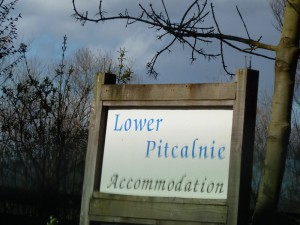 Tha am mapa ag atharrachadh fhathast; air mapaichean OS nas ùire chì sinn na h-ainmean as aosta còmhla ris an fheadhainn nas nuaidhe: Pitcalzean agus Balnabruaich dlùth ri taobh ainmean mar ‘Nigg Oil Terminal Graving Dock’ agus ‘Helipad’. Agus ann an cuid bhliadhnaichean eile, leis an leasachadh as ùire san sgìre, ‘s dòcha gum bi seo ag atharrachadh a-rithist, agus sinn a’ sealltainn air mapa Ros an Ear air a bheil aon uair eile Cnoc a’ Mhuilinn Ghaoithe.
Tha am mapa ag atharrachadh fhathast; air mapaichean OS nas ùire chì sinn na h-ainmean as aosta còmhla ris an fheadhainn nas nuaidhe: Pitcalzean agus Balnabruaich dlùth ri taobh ainmean mar ‘Nigg Oil Terminal Graving Dock’ agus ‘Helipad’. Agus ann an cuid bhliadhnaichean eile, leis an leasachadh as ùire san sgìre, ‘s dòcha gum bi seo ag atharrachadh a-rithist, agus sinn a’ sealltainn air mapa Ros an Ear air a bheil aon uair eile Cnoc a’ Mhuilinn Ghaoithe.
*****************************************************************************************
Placenames 5: English and Scots
As we have already seen, Easter Ross has had a long and fairly colourful history. But one thing has remained constant: there has always been immense interest on the part of church and state rulers in the fertile sheltered land at the head of the Moray Firth. This site was of strategic importance; anyone who was battling for political, military, economic or religious control of the Highlands, by land or sea, had to establish a base here. These people – kings, nobles, bishops, generals, merchants – or their representatives all came into the area, often from the south of Scotland (or even further afield), and in the course of time the Lowland Scots or English languages came with them.
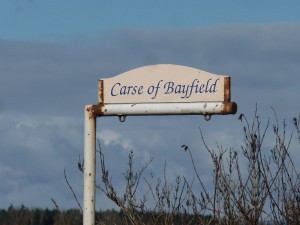 We see on the old maps from the 1590s on (Pont, Blaeu etc) that there were many English forms suddenly appearing for places which already had Gaelic names as used by the local population: Abbotshaven instead of Port an Ab , Hilton instead of Baile a’ Chnuic, Castle Tarbat instead of Baile an Lòin (Ballone). Over time new specimens appeared on the maps: Mounteagle instead of Cnoc na Iolaire, Broomton instead of Baile a’ Bhealaidh, and umpteen placenames ending in -field. The map-makers got their information from the ‘important’ folk of the area, who often weren’t locals, even if they were educated, well-informed individuals such as ministers, teachers, lawyers etc. Maybe they actually believed that these Anglicised versions were ‘better’, more useful, or even more ‘civilised’, and over time maybe even some of the locals began to believe that too, as they had already started using English for more formal business.
We see on the old maps from the 1590s on (Pont, Blaeu etc) that there were many English forms suddenly appearing for places which already had Gaelic names as used by the local population: Abbotshaven instead of Port an Ab , Hilton instead of Baile a’ Chnuic, Castle Tarbat instead of Baile an Lòin (Ballone). Over time new specimens appeared on the maps: Mounteagle instead of Cnoc na Iolaire, Broomton instead of Baile a’ Bhealaidh, and umpteen placenames ending in -field. The map-makers got their information from the ‘important’ folk of the area, who often weren’t locals, even if they were educated, well-informed individuals such as ministers, teachers, lawyers etc. Maybe they actually believed that these Anglicised versions were ‘better’, more useful, or even more ‘civilised’, and over time maybe even some of the locals began to believe that too, as they had already started using English for more formal business.
These English-speakers, and later gentry incomers (or Anglicised local gentry) also gave their homes or estates names with personal significance to them: Brucefield instead of the existing name Cnoc an Tighearna (The Lord’s Hill), Arabella instead of Am Bog, Ankerville instead of Cinn-dèis (Kindeace), Petley, Kimberley etc.
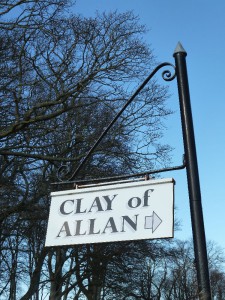 But there was a Scots influence too, both from court administrators and others from the Lowlands at the time of the monasteries and the kings, probably as seen in the names Hiltoun, Newtoun, Meikle Rany on Pont’s map of 1590, and also from those who came over the centuries as farmers or farmworkers, tradesmen and fishermen: Hirsel (small sheep croft), Skinnerton, Fishertown, Carse of Bayfield etc. These people from Moray and further south came, to a large extent, as ordinary workers rather than administrators, and they would have lived side-by-side with the local Gaelic-speaking population. It’s likely that that is the reason for the large number of mixed names with Gaelic roots and English or Scots appendages, like Little Tarrel, Easter Rarichie, Lower Picalzean, Loans of Fearn, Clay of Allan, Balnapaling, Nigg Mains etc.
But there was a Scots influence too, both from court administrators and others from the Lowlands at the time of the monasteries and the kings, probably as seen in the names Hiltoun, Newtoun, Meikle Rany on Pont’s map of 1590, and also from those who came over the centuries as farmers or farmworkers, tradesmen and fishermen: Hirsel (small sheep croft), Skinnerton, Fishertown, Carse of Bayfield etc. These people from Moray and further south came, to a large extent, as ordinary workers rather than administrators, and they would have lived side-by-side with the local Gaelic-speaking population. It’s likely that that is the reason for the large number of mixed names with Gaelic roots and English or Scots appendages, like Little Tarrel, Easter Rarichie, Lower Picalzean, Loans of Fearn, Clay of Allan, Balnapaling, Nigg Mains etc.
In Easter Ross, and especially on the Seaboard, there’s a wealth of historical, geographical and social evidence in the local placenames. If we look closely at the OS maps even today, we can find out which peoples lived there in the past, what languages were spoken, what work people did there over the centuries, who had the political or ecclesiastical power (and when), and what the land looked like centuries back. This piece of the country was and still is attractive and valuable to those from outside its borders.
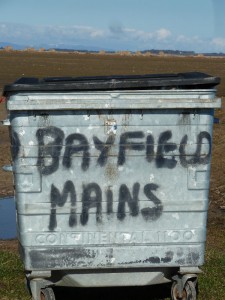 The map is still changing. On recent OS maps we see the oldest names side by side with modern ones: Pitcalzean and Balnabruaich close to names like ‘Nigg Oil Terminal Graving Dock’ and ‘Helipad‘. And it may not be long before that changes again, and (given the latest developments) somewhere on the map of Easter Ross we will once again have a Cnoc a’ Mhuillinn Ghaoithe – Windmill Hill.
The map is still changing. On recent OS maps we see the oldest names side by side with modern ones: Pitcalzean and Balnabruaich close to names like ‘Nigg Oil Terminal Graving Dock’ and ‘Helipad‘. And it may not be long before that changes again, and (given the latest developments) somewhere on the map of Easter Ross we will once again have a Cnoc a’ Mhuillinn Ghaoithe – Windmill Hill.
Ainmean-Àite 4:
na Gàidheal – Creideamh is Caistealan
Creideamh
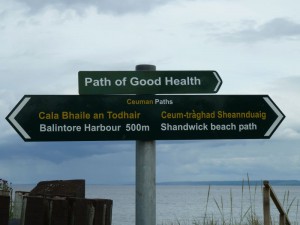 Ged a dh’fhaodas a bhith fianais air ‘Draoidhean’ anns an sgìre anns na h-ainmean ‘Port an Druidh’, agus ‘Cadha Port an Druidh’ air Beinn Neig, ‘s dòcha ceangailte ris na Decantae (c. 120 BC), chan eil eòlas cinnteach againn dè na h-ainmean-àite a dh’fhaodas a dhol air ais chun an àm ron chreideamh Chrìosdail. Mar a chunnaic sinn, ‘s dòcha gur e am facal Gàidhlig ‘righ’ a tha air cùl ‘druidh’. Tha mòran tobraichean ann, gu h-àraidh ann am paraiste Neig, mar Tobar na Slàinte, fhathast ann an-diugh fhèin, air a’ chladach faisg air Port an Druidh, agus Tobar Chormaig, faisg air an tuathanas aig Seannduig. Tha làrach Tobar na h-Iù faisg air ‘an t-sìthean’ (Dùn Rath-riachaidh, Rarichie), agus bha feartan draoidheil leigheis aice a rèir coltais. Bha agus tha saobh-chràbhadh riamh ann anns na bailtean-iasgaich, taobh ri taobh le creideamh Crìosdail làidir, ‘s dòcha air fhagail aca bho àm nan Ceilteach na bu thràithe. Bha an saoghal ro chruaidh ‘s gum biodh iad a’ diùltadh cuideachadh de sheòrsa sam bith.
Ged a dh’fhaodas a bhith fianais air ‘Draoidhean’ anns an sgìre anns na h-ainmean ‘Port an Druidh’, agus ‘Cadha Port an Druidh’ air Beinn Neig, ‘s dòcha ceangailte ris na Decantae (c. 120 BC), chan eil eòlas cinnteach againn dè na h-ainmean-àite a dh’fhaodas a dhol air ais chun an àm ron chreideamh Chrìosdail. Mar a chunnaic sinn, ‘s dòcha gur e am facal Gàidhlig ‘righ’ a tha air cùl ‘druidh’. Tha mòran tobraichean ann, gu h-àraidh ann am paraiste Neig, mar Tobar na Slàinte, fhathast ann an-diugh fhèin, air a’ chladach faisg air Port an Druidh, agus Tobar Chormaig, faisg air an tuathanas aig Seannduig. Tha làrach Tobar na h-Iù faisg air ‘an t-sìthean’ (Dùn Rath-riachaidh, Rarichie), agus bha feartan draoidheil leigheis aice a rèir coltais. Bha agus tha saobh-chràbhadh riamh ann anns na bailtean-iasgaich, taobh ri taobh le creideamh Crìosdail làidir, ‘s dòcha air fhagail aca bho àm nan Ceilteach na bu thràithe. Bha an saoghal ro chruaidh ‘s gum biodh iad a’ diùltadh cuideachadh de sheòrsa sam bith.
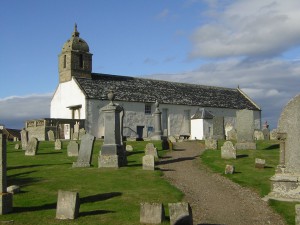 Ach ‘s ann bhon eaglais Chrìosdail a thàinig an àireamh a bu mhotha de na h-ainmean anns an roinn seo. Bho àm Chaluim Chille co-dhiù bha eaglaisean agus manaich ann, gu h-àraidh aig Port MoCholmaig, (Port Naomh Colmag / St Colman) far an robh manachainn Chruithneach. As dèidh sin thàinig Manachainn Rois. ‘S e ‘Feàrn’ an t-ainm a bha oirre roimhe, oir dh’imrich a’ mhanachainn bho Fheàrn, faisg air Eadardan, agus ‘s e Fearn an t-ainm a chùm i sa Bheurla. ‘S e Port an Ab an seann ainm ionadail air Baile an Todhair. Thug Templecroft faisg air Bindal ainm bho Theampall Earach, uamh anns na creagan far an robh (a rèir beul-aithris) seirbheisean-eaglais de sheòrsa air choreigin.
Ach ‘s ann bhon eaglais Chrìosdail a thàinig an àireamh a bu mhotha de na h-ainmean anns an roinn seo. Bho àm Chaluim Chille co-dhiù bha eaglaisean agus manaich ann, gu h-àraidh aig Port MoCholmaig, (Port Naomh Colmag / St Colman) far an robh manachainn Chruithneach. As dèidh sin thàinig Manachainn Rois. ‘S e ‘Feàrn’ an t-ainm a bha oirre roimhe, oir dh’imrich a’ mhanachainn bho Fheàrn, faisg air Eadardan, agus ‘s e Fearn an t-ainm a chùm i sa Bheurla. ‘S e Port an Ab an seann ainm ionadail air Baile an Todhair. Thug Templecroft faisg air Bindal ainm bho Theampall Earach, uamh anns na creagan far an robh (a rèir beul-aithris) seirbheisean-eaglais de sheòrsa air choreigin.
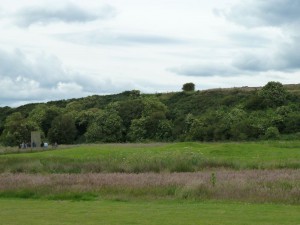 Aig Baile a’ Chnuic tha làrach Caibeal Mhoire ann le ‘Creag na Baintighearna’ air an tràigh, agus ‘Bàrd Mhoire’ (agus Lady Street sa bhaile fhèin, ainm a thàinig le cinnt bho na linntean ron Eaglais Chlèirich.) Tha tobraichean ann an sin cuideachd, m.e. am fear faisg air an allt (is e ga chleachdadh fhathast nuair a bha mise òg), agus fear eile faisg air làrach cladh a’ chaibeil, Lady’s Well, far an deach clann gun bhaisteadh a thiodhlacadh. Thachair an aon rud ri taobh Clach a’ Charraidh, ainm ionadail air Clach Sheannduaig, agus tha e coltach gun deach an fheadhainn a thiodhlachadh an sin cuideachd a dh’eug den cholera. Do na truaghain sin, bha na tursachan Cruithneach iongantach seo, leis na samhlaidhean Crìosdail orra, nan ‘carragh’ dhà-rìribh.
Aig Baile a’ Chnuic tha làrach Caibeal Mhoire ann le ‘Creag na Baintighearna’ air an tràigh, agus ‘Bàrd Mhoire’ (agus Lady Street sa bhaile fhèin, ainm a thàinig le cinnt bho na linntean ron Eaglais Chlèirich.) Tha tobraichean ann an sin cuideachd, m.e. am fear faisg air an allt (is e ga chleachdadh fhathast nuair a bha mise òg), agus fear eile faisg air làrach cladh a’ chaibeil, Lady’s Well, far an deach clann gun bhaisteadh a thiodhlacadh. Thachair an aon rud ri taobh Clach a’ Charraidh, ainm ionadail air Clach Sheannduaig, agus tha e coltach gun deach an fheadhainn a thiodhlachadh an sin cuideachd a dh’eug den cholera. Do na truaghain sin, bha na tursachan Cruithneach iongantach seo, leis na samhlaidhean Crìosdail orra, nan ‘carragh’ dhà-rìribh.
Tha pàirt de Phort MoCholmaig air a bheil Gaza mar ainm; ‘s e ainm bìoballach a th’ ann, agus tha dà mhìneachadh ionadail ann, a rèir Watson: airson ‘s gun robh e mar fhàsach leis a’ ghainmheach a bh’ ann, no air sgàth ‘s gun robh “muinntir Ghaza” (‘Philistines’) aig a’ mhinistear air na daoine an àite leis nach biodh iad a’ dol dhan eaglais tric gu leòr!
Caistealan is Daighnichean
B’ fhìach riamh fearann torrach Mhachair Rois a dhìon, agus bho na linntean a bu thràithe tha iomadh ràth, dùn agus caisteal ann, no tha co-dhiù na h-ainmean air fhàgail againn.
ràth daighneach cruinn (Ceilteach no na bu thràithe)
Rhynie ràthan (tha dà ann, Rhynie agus Meikle Rhynie)
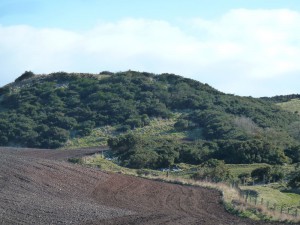 Rarichie ràth-riachaidh (air sgàth nan drisean no a’ chonaisg a th’ ann fhathast?) – làrach daignich Chruithnich, air an robh fhathast ‘Danish Fort’ air a’ mhapa OS 1911. Bha muinntir a’ bhaile riamh glè dheònach creidsinn gum b’ ann bho na Lochlannaich a bha gach leac is dùn, fiù ‘s na leacan Cruithneach fhèin (chuala mi fhìn an sgeul gur ann an sin ‘where the three king’s sons were buried’ nuair a bha mi òg), agus bha clann leithid mo mhàthar an-còmhnaidh a’ cladhach airson ‘Viking treasure’ anns na dùin agus fiù ‘s an làrach Caibeal Mhoire.
Rarichie ràth-riachaidh (air sgàth nan drisean no a’ chonaisg a th’ ann fhathast?) – làrach daignich Chruithnich, air an robh fhathast ‘Danish Fort’ air a’ mhapa OS 1911. Bha muinntir a’ bhaile riamh glè dheònach creidsinn gum b’ ann bho na Lochlannaich a bha gach leac is dùn, fiù ‘s na leacan Cruithneach fhèin (chuala mi fhìn an sgeul gur ann an sin ‘where the three king’s sons were buried’ nuair a bha mi òg), agus bha clann leithid mo mhàthar an-còmhnaidh a’ cladhach airson ‘Viking treasure’ anns na dùin agus fiù ‘s an làrach Caibeal Mhoire.
Ach tha sinn an dòchas gum bi fios a bharrachd againn mu na làraichean Cruithneach seo a dh’aithghearr, leis gum bi planaichean arc-eòlach mòra air an son. http://www.scotsman.com/lifestyle/heritage/new-excavations-to-find-lost-pictish-kingdom-1-2925006
dùn Dunskaith G. Dùn Sgàth, làrach caisteal Rìgh Uilleim (‘an Leòmhann’)
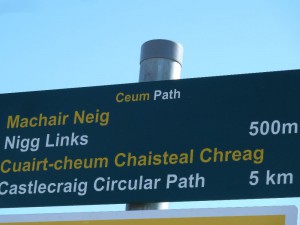 caisteal Castlecraig G. Caisteal Crag (sic) – ceangailte ri Dunskaith, agus làraich no tobhtaichean chaisteil eile air feadh na sgìre, m.e. Caisteal Chathabol, Caisteal Bail’ an Lòin (Ballone) – ‘s e ‘Cast.Terbart’ a bha aig Pont air (c.1590).
caisteal Castlecraig G. Caisteal Crag (sic) – ceangailte ri Dunskaith, agus làraich no tobhtaichean chaisteil eile air feadh na sgìre, m.e. Caisteal Chathabol, Caisteal Bail’ an Lòin (Ballone) – ‘s e ‘Cast.Terbart’ a bha aig Pont air (c.1590).
Tha fiù ‘s Blàr a’ Chath ann, faisg air Rubha Thairbeirt.
Bha sinn a’ coimhead air mòran seòrsaichean eadar-dhealaichte de dh’ainmean-àite Gàidhlig ann am Machair Rois – bailtean is feartan na tìre, an oirthir, an eaglais agus na daignichean. Tha iomadach ainm-àite Gàidhlig eile anns an sgìre, ach b’ e seo taghadh de na raointean as cudromaiche. An ath thuras thig cuairt air na h-ainmean-àite Beurla agus Beurla Ghallda.
*******************************************************************************
Placenames 4
– the Gaels : Faith and Fortresses
Faith
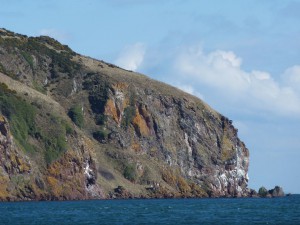 Though there’s a faint chance that we have evidence of Druids in the area in the names ‘Port an Druidh’ and ‘Cadha (pass, ravine) Port an Druidh’ on Nigg Hill, maybe connected to the ancient Decantae tribe (c. 120 BC), we don’t have any names that go back with certainty to pre-Christian times. As we saw, ‘an druidh’ is probably a corruption of the Gaelic ‘an righ’, the king.
Though there’s a faint chance that we have evidence of Druids in the area in the names ‘Port an Druidh’ and ‘Cadha (pass, ravine) Port an Druidh’ on Nigg Hill, maybe connected to the ancient Decantae tribe (c. 120 BC), we don’t have any names that go back with certainty to pre-Christian times. As we saw, ‘an druidh’ is probably a corruption of the Gaelic ‘an righ’, the king.
There are many wells, especially in the parish of Nigg, such as the Well of Health (Tobar na Slàinte) by the shore near Port an Druidh, and St Cormac’s Well (Tobar Chormaig) near Shandwick farm. The site of the Well of the Yew (Tobar na h-Iù) is near the ‘fairy hill’ of Rarichie (Dùn Rathriachaidh), and it allegedly had magical healing properties. Superstition, or acceptance of the supernatural, existed and still does in the fishing communities, side by side with a strong Christian faith, probably passed down from earlier Celtic times. In dangerous professions like fishing, no one turned their nose up at the ‘belt and braces’ approach.
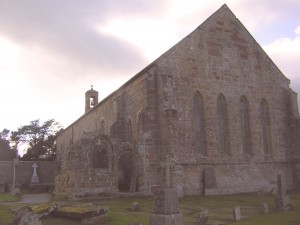 But it’s from the Christian church that the majority of faith-related place-names come. From the time of St Columba at least there were churches and monks here, especially in Port MoCholmaig (St Colman’s Port – Portmahomack), where there was a Pictish monastery. Later there followed Manachainn Rois , the Monastery of Ross. Its previous name had been Feàrn (alder tree) as the monastery moved to Easter Ross from Feàrn, near Edderton, and Fearn is the name the Abbey has kept today in English. Balintore’s old local name was Port an Ab, the Abbot’s port. Templecroft, near Bindal, took its name from Teampall Earach, Easter Temple, a cave in the cliffs where (tradition says) church-services of some kind were held.
But it’s from the Christian church that the majority of faith-related place-names come. From the time of St Columba at least there were churches and monks here, especially in Port MoCholmaig (St Colman’s Port – Portmahomack), where there was a Pictish monastery. Later there followed Manachainn Rois , the Monastery of Ross. Its previous name had been Feàrn (alder tree) as the monastery moved to Easter Ross from Feàrn, near Edderton, and Fearn is the name the Abbey has kept today in English. Balintore’s old local name was Port an Ab, the Abbot’s port. Templecroft, near Bindal, took its name from Teampall Earach, Easter Temple, a cave in the cliffs where (tradition says) church-services of some kind were held.
Near Hilton there’s the site of Caibeal Mhoire, St Mary’s Chapel, with the rock called ‘Creag na Baintighearna’, Our Lady’s Rock, on the beach, 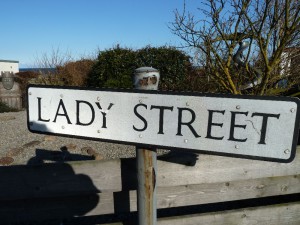 and ‘Bàrd Mhoire’, St Mary’s meadow, and Lady Street in the village itself, a name that has certainly existed since pre-Presbyterian centuries. There are wells there too, near the burn (that one was still being used for domestic water needs when I was young), and another near the chapel cemetary site, Lady’s Well, where unbaptised children were buried. The same thing happened beside Clach a’ Charraidh (Monument Stone), the local name for the Shandwick Stone, and it seems likely that those who died of cholera were also buried there. For these poor souls, the amazing Pictish stones with the Christian symbols on them were monuments, indeed.
and ‘Bàrd Mhoire’, St Mary’s meadow, and Lady Street in the village itself, a name that has certainly existed since pre-Presbyterian centuries. There are wells there too, near the burn (that one was still being used for domestic water needs when I was young), and another near the chapel cemetary site, Lady’s Well, where unbaptised children were buried. The same thing happened beside Clach a’ Charraidh (Monument Stone), the local name for the Shandwick Stone, and it seems likely that those who died of cholera were also buried there. For these poor souls, the amazing Pictish stones with the Christian symbols on them were monuments, indeed.
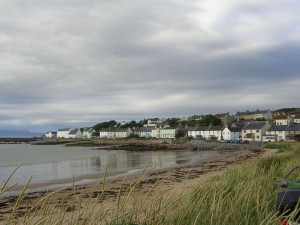 There’s a part of Portmahomack called Gaza; it’s a Biblical name, and there are two local explanations according to Watson. Either it was because it was like the desert of Gaza with all the sand, or because the minister referred to the residents as ‘muinntir Gaza’ (people of Gaza, i.e. ‘Philistines’) as they were not in the habit of attending church often enough!
There’s a part of Portmahomack called Gaza; it’s a Biblical name, and there are two local explanations according to Watson. Either it was because it was like the desert of Gaza with all the sand, or because the minister referred to the residents as ‘muinntir Gaza’ (people of Gaza, i.e. ‘Philistines’) as they were not in the habit of attending church often enough!
Fortresses
The fertile land of Easter Ross was always worth defending, and from the earliest centuries there are many forts, duns and castles, or at least their names, which have come down to us.
ràth – a Celtic or earlier word for a fortified circular enclosure or mound.
> Rhynie = ràthan + i, place of the mounds (there are two, Rhynie and Meikle Rhynie)
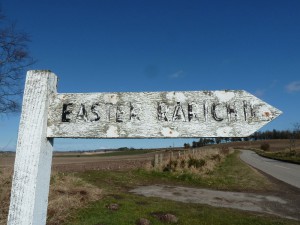 > Rarichie – ràth-riachaidh – ‘fort of the scratching’ (possibly because of the brambles which are still there?). A Pictish fort site, which as late as 1911 was still being called a ‘Danish Fort’ on the OS map. Local people were always very willing to believe that it was the Vikings who were behind every standing stone and mound, even the Pictish stones (I remember myself being told the story ‘that’s where the three king’s sons were buried’ when I was young), and children (like my mother) were always digging for ‘Viking treasure’ below any mound, even on the chapel site.
> Rarichie – ràth-riachaidh – ‘fort of the scratching’ (possibly because of the brambles which are still there?). A Pictish fort site, which as late as 1911 was still being called a ‘Danish Fort’ on the OS map. Local people were always very willing to believe that it was the Vikings who were behind every standing stone and mound, even the Pictish stones (I remember myself being told the story ‘that’s where the three king’s sons were buried’ when I was young), and children (like my mother) were always digging for ‘Viking treasure’ below any mound, even on the chapel site.
But we’re hoping to get a lot more information on the Pictish sites here soon with the grand archeological plans that are afoot now: http://www.scotsman.com/lifestyle/heritage/new-excavations-to-find-lost-pictish-kingdom-1-2925006
dùn – fort
> Dunskaith– Dùn Sgàth, ‘protected fort’, site of a castle built by William the Lion
> Castlecraig – Caisteal Creag / Creag a’ Chaisteil – connected to Dunskaith;
and the sites of other castle ruins around the area, e.g. Cadboll Castle (Caisteal Chatabol), Ballone (Bail’ an Lòin) – which was called ‘Cast.Tarbat’ on Pont’s map of c.1590.
There’s even the name ‘Battlefield‘, ‘Blar a’ Chath’, near Tarbat Ness.
In these last 3 issues we’ve been looking at the Gaelic names that dominate the others around the Seaboard under three main headings – settlements and landscape, the coast, faith and fortresses. In the last installment it’ll be the turn of Scots and English names.
Ma bhios ùine agus ùidh agaibh a-màireach, Disathairne 25 den Cheitean aig 2f, bidh cothrom math ann na naidheachdan arc-eòlach as ùire mu Chlach Neig a chluinntinn fhad’s a tha sibh a’ coiseachd air Slighe an Easbaig, le deasbad is srùbag as a dhèidh.
Barrachd fiosrachaidh an seo:
http://www.niggoldtrust.org.uk/news.asp
If you have time and interest tomorrow, Sat 25 May at 2pm, there’s a great opportunity to hear the latest archaeological news about the Nigg Stone while strolling round the Bishops’s Walk, followed by discussion and refreshments.
Click link above for more information.
Chaidh sgoilearan clas 6/7 à Bun-sgoil Chnoc na Creige, ann am Baile Dhubhthaich, air turas gu Pàrlamaid Diluain sa chaidh airson seisean tro mheadhan na Gàidhlig.
Class 6/7 GME Craighill Primary, Tain, visited the Scottish Parliament for a Gaelic tour and activities last Monday .
http://parlamaidalba.wordpress.com/2013/05/02/bailedhubhthaich/
Looks like they had fun, especially creating their own MSP profile…

Ainmean-àite ann am Machair Rois 3 –
na Gàidheal: an oirthir
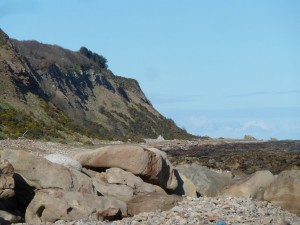 ‘S e oirthir an Ear am pàirt as drùidhtiche den sgìre againn agus tha na h-ainmean-àite a’ toirt fianais air sin. Anns an t-uabhas de dh’ainmean ionadail air creagan sònraichte, mar eisimpleir, chithear cho cudromach agus a bha a’ mhuir aig daoine, airson iasgaich agus mar dhòigh-shiubhail.
‘S e oirthir an Ear am pàirt as drùidhtiche den sgìre againn agus tha na h-ainmean-àite a’ toirt fianais air sin. Anns an t-uabhas de dh’ainmean ionadail air creagan sònraichte, mar eisimpleir, chithear cho cudromach agus a bha a’ mhuir aig daoine, airson iasgaich agus mar dhòigh-shiubhail.
Tha aon Bheinn ann, Beinn Neig. Chan eil e cho àrd ri beanntan eile ann an Ros, ach ‘s e feart gu math greadhnach a th’ ann. Aig a’ cheann eile den ‘Seaboard’, tha Rubha Thairbeirt a’ cumail faire air an leth-eilean.
creag – Tha cus ann airson liosta coileanta ach ‘s ann air oirthir an Ear, eadar an Rubha agus Baile a’ Chnuic, a nochdas a’ mhòr-chuid:
Creag Ruadh, Creag Mhaol, Creagan Dubha, Creag a’ Chinn Bhig amssa.
Tha cuid mhòr de na h-ainmean ceangailte ri eòin:
Creag nan Eun, Creag na h-Eala, Rubha na h-Iolaire,
fianais air a’ phailteas de dh’eòin-mhara a bha ann agus a tha ann fhathast an sin.
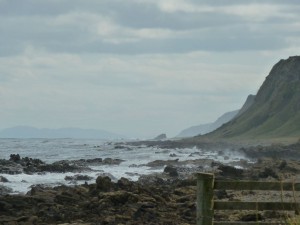 Tha stac, clach, sròn agus ail (creag) ann cuideachd:
Tha stac, clach, sròn agus ail (creag) ann cuideachd:
Stac Mòr agus Stac Beag , Clach Dhubh, Clach Ghlas, Sròn Liath, Tarail. Tha abairt ann: “Tarail Mhòr is Tarail Bheag is Tarail fo na Chreag”.
Ann an Down to the Sea (J. Macdonald, A. Gordon, J. Sutherland), air fhoillseachadh ann an 1971 bunaichte air rannsachadh nas tràithe, tha mapa làmh-sgrìobhte le ainmean ionadail air cha mhòr gach clach agus creag eadar Baile a’ Chnuic agus Geanies (Gàthan). Bha iad air an cruinneachadh le Anne Gordon agus na peathraichean J. Nic Dhòmhnaill (an sgrìobadair) agus J. Shutharlanach (an dealbhadair), an dithis aca às a’ bhaile, bho na h-iasgairean a b’ aosta. Bha na creagan seo cudromach mar chomharran-mara, airson clèibh a chur sìos agus a lorg, agus airson seòladaireachd.
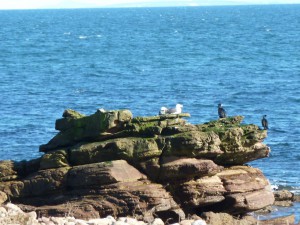 ‘S ann sa Ghàidhlig a tha a’ mhòr-chuid agus ‘s e ainmean air leth cuingealaichte a th’ annta; chan eil iad rin lorg air mapaichean ‘oifigeil’. Tha ainmean dealbhach ann mar ‘Boineid Frangach’ (sic) agus ‘Skaravak’ (creag nan sgarbhan – eòin a-rithist, agus ainm freagareach), Tha feadhainn eile ceangailte ris an eachdraidh ionadail:- ‘Creag na Bainsheann’ (sic) – na Baintighearna, faisg air làrach Caibeal Mhoire, no ri daoine na sgìre: ‘Eilean Sheòrais’, Jessieport, Tom & Mary Port. Bidh mòran de na h-ainmean an sin air an cleachdadh fhathast an-diugh fhèin am measg sheantansan Beurla, oir chan eil ainmean Beurla ann orra. ‘I’m going to the Porst / Porst Culag / Skaravak / Uilleam’s Pool, the Uaireachan’ amsaa.
‘S ann sa Ghàidhlig a tha a’ mhòr-chuid agus ‘s e ainmean air leth cuingealaichte a th’ annta; chan eil iad rin lorg air mapaichean ‘oifigeil’. Tha ainmean dealbhach ann mar ‘Boineid Frangach’ (sic) agus ‘Skaravak’ (creag nan sgarbhan – eòin a-rithist, agus ainm freagareach), Tha feadhainn eile ceangailte ris an eachdraidh ionadail:- ‘Creag na Bainsheann’ (sic) – na Baintighearna, faisg air làrach Caibeal Mhoire, no ri daoine na sgìre: ‘Eilean Sheòrais’, Jessieport, Tom & Mary Port. Bidh mòran de na h-ainmean an sin air an cleachdadh fhathast an-diugh fhèin am measg sheantansan Beurla, oir chan eil ainmean Beurla ann orra. ‘I’m going to the Porst / Porst Culag / Skaravak / Uilleam’s Pool, the Uaireachan’ amsaa.
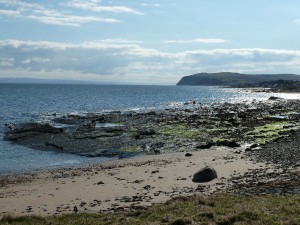 Tha ‘Port Lark’ ann cuideachd, ach tha e coltach nach e eun a tha ann an turas seo; seo cruth Beurla de ‘Làirig’, ‘Lathaich’ air a mhapa (oidhirp fuaimneachaidh ionadail a sgrìobhadh?) Tha ‘the Larachans’ ann cuideachd, sreath chreagan ri taobh an Phuirt, ‘s dòcha le ciall ceangailte.
Tha ‘Port Lark’ ann cuideachd, ach tha e coltach nach e eun a tha ann an turas seo; seo cruth Beurla de ‘Làirig’, ‘Lathaich’ air a mhapa (oidhirp fuaimneachaidh ionadail a sgrìobhadh?) Tha ‘the Larachans’ ann cuideachd, sreath chreagan ri taobh an Phuirt, ‘s dòcha le ciall ceangailte.
(Ma bhios barrachd fios ionadail aig daoine sam bith mu na h-ainmean seo no feadhainn eile, bhithinn toilichte cluinntinn bhuaibh! Chòrdadh e rium ionnsachadh an uiread ‘s a ghabhas mus tèid a h-uile rud a dhìochuimhneachadh.)
Air taobh eile Rubha Thairbeirt, eadar an taigh-solais agus Port MoCholmaig, ‘s e port an t-ainm as cumanta air a’ chladach. Chan e fìor chalaidhean a tha annta ach acarsaidean beaga, oir tha an taobh sin nas fhasgaiche. ‘S e cruinneachadh inntinneach de dh’ainmean a tha an seo cuideachd, le ainmean pearsanta – Port Uilleim, no tuairisgeulach: Port a’ Chrithinn (craobhan, B. aspen), Port nam Marbh, Port a’ Chaisteil amsaa. ‘S e Port nam Faochag a th’ ann an Wilkhaven, fìor chaladh (ged a tha e beag) faisg air Rubha Thairbeirt.
 Aig ceann eile an leth-eilein tha Beinn Neig agus an oirthir mun chuairt oirre, le creagan agus tràighean. Chan eil uiread de dh’ainmean air a’ mhapa an seo, ‘s dòcha gun robh e ro chunnartach dha na h-iasgairean, leis na sgeirean mar ‘the King’s Sons’ agus Creag Dhaibhidh, agus tha mòran uamhan ann mar ‘the King’s Cave’. ‘S dòcha gur e Port an Rìgh a th’ ann am Port an Druidh a-rèir Watson cuideachd, seach ceangal ri draoidhean . Chan eil fìor chinnt ann cò na rìghrean, agus iomadach fionnsgeul mu an cuairt. Ach àrd air mullach na creige tha Castlecraig (creag a’ Chaisteil), comharra cudromach do mharaichean fada a-muigh air a’ mhuir.
Aig ceann eile an leth-eilein tha Beinn Neig agus an oirthir mun chuairt oirre, le creagan agus tràighean. Chan eil uiread de dh’ainmean air a’ mhapa an seo, ‘s dòcha gun robh e ro chunnartach dha na h-iasgairean, leis na sgeirean mar ‘the King’s Sons’ agus Creag Dhaibhidh, agus tha mòran uamhan ann mar ‘the King’s Cave’. ‘S dòcha gur e Port an Rìgh a th’ ann am Port an Druidh a-rèir Watson cuideachd, seach ceangal ri draoidhean . Chan eil fìor chinnt ann cò na rìghrean, agus iomadach fionnsgeul mu an cuairt. Ach àrd air mullach na creige tha Castlecraig (creag a’ Chaisteil), comharra cudromach do mharaichean fada a-muigh air a’ mhuir.
Ged a tha argamaidean ann airson freumha Lochlannaich anns an fhacal ‘Neig’ (vik ) mar a chunnaic sinn, is dòcha gun tàinig e bho fhacal Gàidhlig:
eag > gin. eige > an eige (> a’ Neige) : (B. notch, indentation)
Chan eil cinnt ann an e Tràigh Neig fhèin (eag san oirthir), na Sùdraichean, no làrach na seann eaglaise (aig ceann eige san tìr) a bha anns an eag seo. ‘S e ‘place of the tanners’ a bh’ anns Na Sùdraichean, agus mar sin, leis an uiread de leathair a bu chòir a bhith ann, ‘s dòcha gur e an fhìrinn a th’ anns na sgeulachdan mu ghreusaichean!
*************************************************************************************************
Placenames of Easter Ross 3 – the Gaels:
the coast
From the landscape point of view, the eastern coastline is the most impressive part of our area, and the placenames bear witness to this. In the huge number of local names for particular rocks, for example, we see how important the sea was to people, for fishing and for travel.
There’s one Ben, Beinn Neig – the Hill of Nigg. It’s not as high as other bens in Ross-shire, but it’s still a majestic feature. At the other end of the Seaboard, Rubha Thairbeirt (the Point of Tarbat), Tarbat Ness, watches over the peninsula.
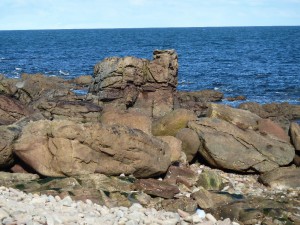 creag – rock, crag. There are too many too list, but the majorty of named crags are on the eastern stretch of coast, between Tarbat Ness and Hilton, e.g.
creag – rock, crag. There are too many too list, but the majorty of named crags are on the eastern stretch of coast, between Tarbat Ness and Hilton, e.g.
Creag Ruadh (red rock), Creag Mhaol (bald rock), Creagan Dubha (black rocks), Creag a’ Chinn Bhig (rock of the little head) etc.
There are quite a few with names connected to birds:
Creag nan Eun (rock of the birds), Creag na h-Eala (rock of the swan), Rubha na h-Iolaire (point of the eagle),
evidence of the abundance of seabirds which was and still is to be found there.
There are the names with stac (stack), clach (stone), sròn (nose) and ail (cliff) too, e.g.
Stac Mòr and Stac Beag (big and little stack), Clach Dhubh (black stone), Clach Glas (blue-grey stone), Sròn Liath (white-grey nose), Tarrel (Tarrail = tar+ail – over-cliff).
There’s saying about the Tarrels: “Tarail Mhòr is Tarail Bheag is Tarail fo na chreag” (Big Tarrel and Little Tarrel and Tarrel under the Cliffs – Rockfield).
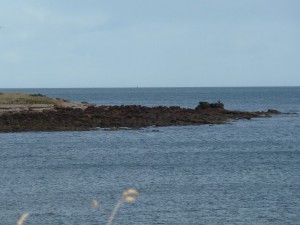 In Down to the Sea (J.Macdonald, A.Gordon, J. Sutherland), printed as a book in 1971 but researched earlier, there’s a hand-written map with the local names of almost every rock and crag between Hilton and Geanies, collected by Anne Gordon and the Hilton sisters Jessie Macdonald and Hansy Sutherland (the illustrator of the book) from the old fishermen.These rocks were important as sea-markers, for setting and locating creels, and for navigation.
In Down to the Sea (J.Macdonald, A.Gordon, J. Sutherland), printed as a book in 1971 but researched earlier, there’s a hand-written map with the local names of almost every rock and crag between Hilton and Geanies, collected by Anne Gordon and the Hilton sisters Jessie Macdonald and Hansy Sutherland (the illustrator of the book) from the old fishermen.These rocks were important as sea-markers, for setting and locating creels, and for navigation.
The majority of these names are Gaelic, and have a very local reference – you won’t find them on ‘official maps’. There are descriptive names, like ‘Bonaid Frangach’ (Frenchman’s bonnet) and the well-named ‘Skaravak’ (Gaelic sgarbag – pronounced Skaravak, means ‘rock of the cormorants’ – sgarbh=cormorant – birds again). Others are linked to local history: ‘Creag na Bainsheann’ = Creag na Baintighearna (rock of Our Lady), near the site of the chapel of St Mary, or 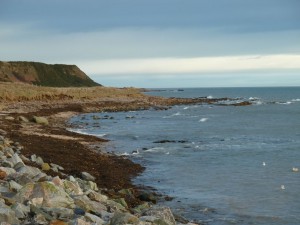 to local characters: ‘Eilean Sheòrais’ – George’s Island, Jessieport, Tom and Mary Port. The Porst itself is just the Gaelic pronunciation of ‘port’. Many of these Gaelic names are still used today in the middle of sentences in English, as there are no English names for them. “I’m going to the Porst / to Porst Culag / to Uilleam’s Pool / the ‘Wireachan’,” etc.
to local characters: ‘Eilean Sheòrais’ – George’s Island, Jessieport, Tom and Mary Port. The Porst itself is just the Gaelic pronunciation of ‘port’. Many of these Gaelic names are still used today in the middle of sentences in English, as there are no English names for them. “I’m going to the Porst / to Porst Culag / to Uilleam’s Pool / the ‘Wireachan’,” etc.
There’s a ‘Port Lark’ too, but this probably has nothing to do with birds this time – it’s an Angliscised version of Port Làirig or Làirich (obscure: ‘port of the site / battlefield/ floor / ruins/ mares’– take your pick), given as ‘Laithich’ on the map – possibly an attempt to render the local pronunciation of soft ‘r’ as ‘th’. There are also ‘the Larachans’, a row of rocks beside the Port, which may have a related meaning.
(If anyone has more local knowlege about any of these, please get in touch! I’d love to learn as much as possible about them before it all gets forgotten.)
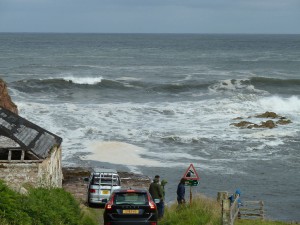 On the other side of Tarbat Ness, between the lighthouse and Portmahomack, Port is the most common name along the shore. These aren’t real harbours, just small anchorages, as this is the more sheltered side. It’s an interesting collection of names we find there too, including personal names, like ‘Port UIlleim’, or descriptive ones like ‘Port a’ Chrithinn’ (Port of the aspen trees), ‘Port nam Marbh’ (Port of the Dead), ‘Port a’ Chaisteil’ (Castle Port) etc. Wilkhaven is called ‘Port nam Faochag’, which literally means ‘port of the whelks’, a real harbour this time, small though it is, close to Tarbat Ness.
On the other side of Tarbat Ness, between the lighthouse and Portmahomack, Port is the most common name along the shore. These aren’t real harbours, just small anchorages, as this is the more sheltered side. It’s an interesting collection of names we find there too, including personal names, like ‘Port UIlleim’, or descriptive ones like ‘Port a’ Chrithinn’ (Port of the aspen trees), ‘Port nam Marbh’ (Port of the Dead), ‘Port a’ Chaisteil’ (Castle Port) etc. Wilkhaven is called ‘Port nam Faochag’, which literally means ‘port of the whelks’, a real harbour this time, small though it is, close to Tarbat Ness.
At the other end of the peninsula we have Beinn Neig, the Hill of Nigg, and the the coast around it with its crags and beaches. There fewer names on the map round here, perhaps because it was too dangerous for fishermen, with the ‘King’s Sons’ and ‘Creag Dhaibhaidh’ (Davy’s Rock), and there are many caves, 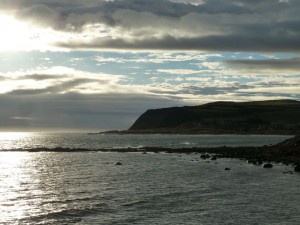 like ‘the Kings Cave’. It’s probable that ‘Port an Druidh, noted by Watson, had nothing to do with druids but came from ‘Port an Righ’, King’s Port. It’s not absolutely certain who these kings were, but there are many legends about them. On top of the cliff is Castlecraig (Creag a’ Chaisteil), an important landmark to seamen far out at sea.
like ‘the Kings Cave’. It’s probable that ‘Port an Druidh, noted by Watson, had nothing to do with druids but came from ‘Port an Righ’, King’s Port. It’s not absolutely certain who these kings were, but there are many legends about them. On top of the cliff is Castlecraig (Creag a’ Chaisteil), an important landmark to seamen far out at sea.
Although there are arguments for Viking roots in the word ‘Neig’ (possibly from ‘vik’, as we saw earlier), it’s also quite likely that it came from a Gaelic word:
eag, meaning a notch or cleft, or indentation. ‘The hill of of the cleft’ would be ‘Beinn an eige’ in Gaelic, which could easily have turned into Beinn Neig , and then Nigg. It’s not clear which ‘cleft’ would have been meant – the Bay of Nigg, the Sutors, or the site of Old Nigg Church on the edge of a small ravine. The Sutors in Gaelic are Na Sùdraichean, ‘place of the tanners’, so with all that leather about, perhaps the shoemaker stories are true!
Ainmean-Àite ann am Machair Rois 2
– Na Gàidheil: Bailtean is Cruth na Tìre
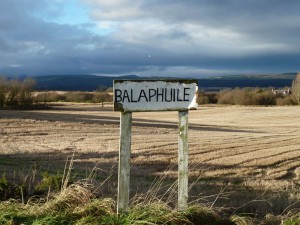 Chunnaic sinn mìos sa chaidh gu bheil iomadh ainm-àite ann am Machair Rois a thàinig bho na Cruithnich agus na Lochlannaich, ach ‘s ann bhon t-sluagh Ghàidhealach a thàinig a’ mhòr-chuid de na h-ainmean san sgìre seo. Ged a bha cuid Bheurla agus Bheurla Ghallda ri lorg tro na linntean ann an Ros an Ear, mar a chithear ann an artaigil eile, ‘s e prìomh chànan muinntir na sgìre a bha ann an Gàidhlig bho na Meadhan Aoisean tràth a-nuas chun na ficheadamh linne. Air an adhbhar sin bha buaidh Ghàidhlig làidir air na h-ainmean-àite, an dà chuid ann an ainmean gu tur Gàidhlig agus ann an ainmean le ceanglaichean ri cànanan eile, mar a chithear ann an eileamaidean measgaichte agus eadar-theangachaidhean.
Chunnaic sinn mìos sa chaidh gu bheil iomadh ainm-àite ann am Machair Rois a thàinig bho na Cruithnich agus na Lochlannaich, ach ‘s ann bhon t-sluagh Ghàidhealach a thàinig a’ mhòr-chuid de na h-ainmean san sgìre seo. Ged a bha cuid Bheurla agus Bheurla Ghallda ri lorg tro na linntean ann an Ros an Ear, mar a chithear ann an artaigil eile, ‘s e prìomh chànan muinntir na sgìre a bha ann an Gàidhlig bho na Meadhan Aoisean tràth a-nuas chun na ficheadamh linne. Air an adhbhar sin bha buaidh Ghàidhlig làidir air na h-ainmean-àite, an dà chuid ann an ainmean gu tur Gàidhlig agus ann an ainmean le ceanglaichean ri cànanan eile, mar a chithear ann an eileamaidean measgaichte agus eadar-theangachaidhean.
Leis gu bheil uiread de dh’ainmean Gàidhlig anns an sgìre, dèiligidh mi ri taghadh comharrail ann an diofar roinnean – an t-seachdain seo bailtean agus cruth na tìre, an ath mhìos cruth na h-oirthir.
Bailtean, tuineachaidhean
Bal- G. baile Gnàth-eileamaid as cumanta ann an cruthan Beurla nan ainmean air a’ mhapa, leis cho dùmhail ‘s a bha na tuineachaidhean air an fhearann torrach againn an coimeas ris a’ Ghàidhealteachd air fad.
Balintore (Baile an Todhair) – fianais na h-obrach le lìon o chionn mòran linntean. Bha ‘Balintoir‘ mìle no dhà a-staigh san tìr air mapa Phont (c.1590) agus ‘s e ‘Abotsheaun‘ a tha aige air a’ bhaile air an oirthir. Bha ‘Port an Ab’ cuideachd air Baile an Todhair aig àm WF Watson, c. 1900, air sgàth a’ cheangail ri Manachainn Rois.
Balaldie G. Baile + allt + -aigh (seann tuisal ionadach > ie) ; ged nach eil allt ann a-nis. C.f. Loch Slin – an robh drèanadh tuathanasach na b’ fheàrr a’ tioramachadh an fhearainn?
Balnagore G. Baile na gobhar
Balmuchy Baile nam muc? Tha ‘Balemucky’ aig Pont (c.1590). Tha an tùs mì-chinnteach, a-rèir Watson. ‘S dòcha bhon Chruithnis ‘Pitmuchy‘ – baile nam muc, air neo bho na seann fhaclan Gàidhlig / Gaeilge ‘much‘ (ceò), no ‘mocha‘ (cailleach-oidhche).
Ballone / Balloan Bail’ an lòin
Balaphuile Baile + poll /phuill
Tha iomadach eiseimpleir eile ann, m.e.
Balnabruach, Balnaha, Balnuig, Balnagall, Balblair, Balinroich, Balachladich, Balindrum, Balcherry.
Tha e coltach gun robh seann tuineachaidhean nam measg air an robh ‘Pit-‘ seach ‘Bal-‘ bho thùs, oir tha eisempleirean gu leòr ann far a bheil ‘Pit’ anns a’ chruth Bheurla agus ‘Baile’ anns an ainm Ghàidhlig, agus far a bheil eileamaid shònrachaidh Gàidhlig as dèidh ‘Pit-‘
Pitcalnie Baile-chailnidh, no Cuilt Eararaidh – tuathanas air an àite chruiaidh, no: cùil far an deach arbhar a dàthadh. Strath of Pitcalnie – Srath Chuilt Eararaidh.
Pitcalzean Bail’ a Choillean – baile na coille bhige. Pont ‘Pitkaill’ (c.1590)
Pitkerrie Baile-Chèiridh , bho ciar > cèiread, no bhon fhacal ‘cèir’ – bha sgeulachd ann nach do rinn na seilleanan ach cèir seach mil às a’ chonasg an sin, a-rèir Watson.
Agus tha ainmean Beurla air a’ mhapa air an robh cruthan Gàidhlig fad linntean:
Broomtown G. Baile a’ Bhealaidh, Ballewallie ann am Beurla Ghallda. Tha amaladh-cainnte ann a bha beò fhathast c. 1970:
Caorich Baile a’ Bhealaidh ag ithe bealaidh aig beulaibh Baile a’ Bhealaidh.
Cruth na Tìre
A-staigh san tìr chan eil cruthan cho drùidhteach agus a tha iad ann an Ros an Iar, ach tha cnocan, lochan is eile ann a thug ainmean sònraichte dhan sgìre. Ma bheir thu sùil air mapa OS sam bith, chì thu an t-uabhas de dh’ainmean Gàidhlig a tha againn fhathast air feartan na tìre air feadh na sgìre.
Cnoc Cnocan Seasg (neo-thorrach), Cnoc Taigh Chaluim, Cnoc a’ Mhaide, Cnoc Grìanach, fiù ‘s Cnoc a’ Mhuillinn Ghaoithe.
Baile a’ Chnuic – ainm Gàidhlig air Hilton; neo ‘Bail’ a’ Chnuinc’, mar a chanadh muinntir na sgìre.
Druim – Drumancroy (an druima cruaidh), Drumossie (+ mosach), Balindrum.
Allt Allt nan Dàmh (seann roinn-shealgair air Beinn Neig), air a’ mhapa OS ann an 1911 ‘Aultandown’; Aldie / Balaldie (fiù ‘s gun allt an-diugh).
Loch Lochslin (slinn, inneal breabadair, B. sley), nach eil ann tuilleadh, Loch Eye (faic mìos sa chaidh, Na Lochlannaich), Loch Clais a’ Chrèadha, Loch Dhu, agus iomadach ‘Loch’ beag air a’ Mhoraich Mhòr. Bha ‘Inverlochslin‘ air Inver roimhe > Inbhir na h-aibhne bho Loch Slinne.
Clais Clashnamuaich (Clais na maigheach), Clais a’ Chreadha
Cul Culnaha (Cul/Cùl na h-àtha), Cullisse (cùl + lios)
Bog Bogbain, Am Bog (B. Arabella)
Moraich (< mor’ oich) = fearann còmhnard ri taobh na mara: a’ Mhoraich Mhòr
Mios sa tighinn bheir sinn sùil air cuid de na h-ainmean Gàidhlig timcheall air an oirthir.
*****************************************************************
Placenames of Easter Ross 2
– the Gaels: townships and the landscape
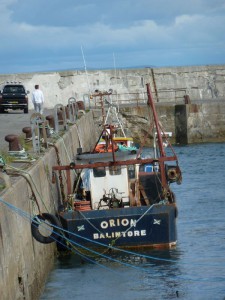 Last month we saw that there are many placenames in Easter Ross which came from from the Picts and the Vikings, but the vast majority of placenames in this area came from the Gaels. Although there was some English and Scots used in Easter Ross over the centuries (as we’ll see later), the main language of the local people from the early Middle Ages to the 20th century was Gaelic. For that reason Gaelic had a particularly strong impact on placenames, both in completely Gaelic names and in names with combinations of Gaelic and other languages.
Last month we saw that there are many placenames in Easter Ross which came from from the Picts and the Vikings, but the vast majority of placenames in this area came from the Gaels. Although there was some English and Scots used in Easter Ross over the centuries (as we’ll see later), the main language of the local people from the early Middle Ages to the 20th century was Gaelic. For that reason Gaelic had a particularly strong impact on placenames, both in completely Gaelic names and in names with combinations of Gaelic and other languages.
As there’s such a wealth of names, I’ll just be looking at a representative sample here, under different headings, starting this month with townships and the landscape, and the coast next month.
Townships and settlements
Bal – Gaelic baile = township. The one most common basic element in the names on the map in their modern (Anglicised) form, a sign of the density of the population in our fertile area compared with the Highlands as a whole.
Balintore < Baile an Todhair – bleaching town: evidence of the local linen industry down the centuries. ‘Balintoir‘ was a mile or two inland on Pont’s map of c.1590, and the harbour settlement was called ‘Abotsheaun‘ (Abbotshaven). In WF Watson’s time (c. 1900) Balintore was also called ‘Port an Ab’ (Abbot’s Port), due to its connections with Fearn Abbey.
Balaldie <. Baile + allt (stream) + -aigh (typical place-ending) ; although there isn’t a stream there nowadays. Remembering the disappearing Loch Slin, perhaps improved farm drainage led to a general drying out, or rerouting of waterways?
Balnagore < Baile na gobhar – town of the goats
Balmuchy possibly < Baile nam muc – town of the pigs (it’s on Pont’s 1590 map as Balemucky). Origin obscure, according to Watson. Possibly from Pictish for pigs or from Old Gaelic for mist or even owls – take your pick!Ballone / 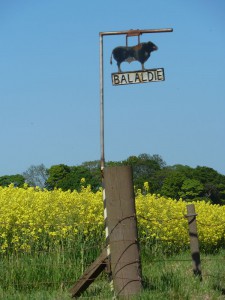 Ballone / Balloan < Bail’ an lòin – settlement of the low damp meadow
Ballone / Balloan < Bail’ an lòin – settlement of the low damp meadow
Balnaphuile < Baile + poll / phuill – settlement of the boggy pool
There are countless other examples, such as:
Balnabruach, Balnaha, Balnuig, Balnagall, Balblair, Balinroich, Balachladich, Balindrum, Balcherry.
It’s likely that there are very old settlements among those whose names would originally have included the Pictish ‘Pit-‘, instead of the Gaelic ‘Bal-‘. We still see plenty of examples of these mixed elements in placenames wihch have kept the ‘Pit-‘ in their English versions, along with a second Gaelic element:
Pitcalnie < Baile-chailnidh, or Cuilt Eararaidh. “Farm at the hard place”. The second Gaelic name is “secluded spot of the parching”. Strath of Pitcalnie – Srath Chuilt Eararaidh.
Pitcalzean < Bail’ a Choillean – town of the small wood. (Pont ‘Pitkaill’)
Pitkerrie < Baile-Chèiridh , < ciar > cèiread (dusk), or from the word ‘cèir‘ (wax) – there was a story that bees could only make wax, not honey, from all the whins there, according to Watson.
Pitmaduthy < Pit/Baile (m)ic Dhuibh – Macduff’s stead
And there are English names on the map now for places that had Gaelic names for centuries, for example
Broomtown / Broomton < Baile a’ Bhealaidh (town of the broom), Ballewallie in Scots.
There’s a Gaelic tongue-twister about it that was still around well into the 20th century:
Caorich Baile a’ Bhealaidh ag ithe bealaidh aig beulaibh Baile a’ Bhealaidh. (“Broomtown sheep eating broom in front of Broomtown”. – It isn’t quite as effective in English!)
The Landscape:
In inland Easter Ross we don’t have the impressive landmarks that Wester Ross has, but we still have our hills, lochs and so on that added their own names to the map. If you look at any OS map, you’ll see the striking number of Gaelic names we still have for landscape features throughout the area.
Cnoc = hill, e.g. Cnocan Seasg (infertile hills), Cnoc Taigh Chaluim (hill of Calum’s house), Cnoc a’ Mhaide (hill of the stick), Cnoc Grìanach (sunny hill), even Cnoc a’ Mhuillinn Ghaoithe (Windmill Hill).
Baile a’ Chnuic – Gaelic names for Hilton; or ‘Bail’ a’ Chnuinc’, (Bal -a-chruink) as the locals pronounced it.
Druim – = back, ridge, e.g. Drumancroy (an druima cruaidh= the hard ridge), Drumossie (+ mosach, boggy, moorlike), Balindrum (town of the ridge)
Allt = stream, e.g. Allt nan Dàmh (stream of the deer – old hunting ground on the Hill of Nigg), on the OS map of 1911 as ‘Aultandown’;
Other examples: Aldie, Balaldie (even if now ‘streamless’)
Loch Lochslin (loch +slinn, weaving implement, English ‘sley’), no longer extant, Loch Eye (see last month – the Vikings), Loch Clais a’ Chrèadha (loch of the clay hollow), Loch Dhu (black), and many other tiny lochs on the Moraich Mòr. Inver used to be called ‘Inverlochslin‘ > at the mouth of the river from Loch Slin.
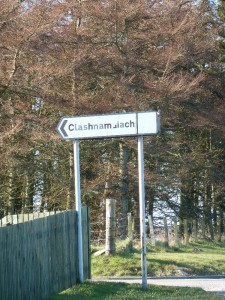 Clais = ditch, hollow, e.g. Clashnamuaich (Clais na maigheach – hollow of the hares), Clais a’ Chreadha (clay hollow)
Clais = ditch, hollow, e.g. Clashnamuaich (Clais na maigheach – hollow of the hares), Clais a’ Chreadha (clay hollow)
Cul = back, nook, e.g. Culnaha (Cul/Cùl na h-àtha – ‘kiln-nook’), Cullisse (cùl + lios – garden, enclosure)
Bog = marsh, moss, soft ground , e.g. Bogbain (white marsh), Am Bog (The Marsh – renamed Arabella)
Moraich = sea plain, as in the Morrich More / a’ Mhoraich Mhòr – ‘the big plain by the sea’
Next time we’ll look at some of the many Gaelic placenames around the Seaboard coastline.
Anyone who’s seriously interested in local names should try to get hold of ‘Place Names of Ross and Cromarty’ by WJ Watson, originally published in 1904, reprinted 1976. There are also wonderful old maps you can look at on the website of the national Library of Scotland: http://maps.nls.uk/scotland/index.html
Ainmean-Àite ann am Machair Rois 1 – na Cruithnich agus na Lochlannaich
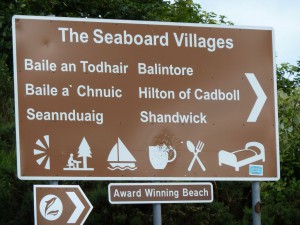 Ged nach e ceàrnaidh glè fharsaing a tha ann am Machair Rois, tha cruth na tìre eadar-dhealaichte agus eachdraidh fhada is inntinneach aice, agus tha seo gu math follaiseach anns na h-ainmean-àite a dh’fhàg gach sluagh, agus gach ginealach, air a’ mhapa. ‘S urrainn dhuinn am leantainn ann am mapaichean sean is ùr, ann an goireasan sgrìobhte (mar W J Watson, Placenames of Ross and Cromarty) agus tro fhiosrachadh bho mhuinntir nam bailtean-iasgaich fhèin, agus an ceangal ris na feartan caochlaideach agus seasmhach den tìr agus de dhòigh-bheatha muinntir na sgìre.
Ged nach e ceàrnaidh glè fharsaing a tha ann am Machair Rois, tha cruth na tìre eadar-dhealaichte agus eachdraidh fhada is inntinneach aice, agus tha seo gu math follaiseach anns na h-ainmean-àite a dh’fhàg gach sluagh, agus gach ginealach, air a’ mhapa. ‘S urrainn dhuinn am leantainn ann am mapaichean sean is ùr, ann an goireasan sgrìobhte (mar W J Watson, Placenames of Ross and Cromarty) agus tro fhiosrachadh bho mhuinntir nam bailtean-iasgaich fhèin, agus an ceangal ris na feartan caochlaideach agus seasmhach den tìr agus de dhòigh-bheatha muinntir na sgìre.
Bidh mi a’ sealltainn ris na sluaghan agus na cànanan sin anns na h-ath artaigil no dhà.
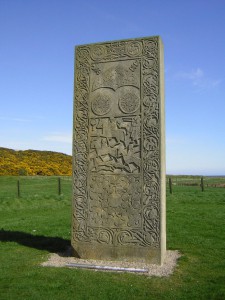 Na Cruithnich
Na Cruithnich
Ged a tha fios againn bho Ptolemy, neach-cruinn-eòlais Ròmanach, mu na Decantae, treubh a bha stèidhichte ann an Ros an Ear c. 120 AD, chan eil ainmean-àite air fhàgail a tha le cinnt bhuapa. ‘S e na Cruithnich an ath shluagh anns an sgìre a nochd anns na cunntasan, air an ainmeachadh leis na Ròmanaich agus anns na sgrìobhaidhean mu Chalum Chille. Bha iad a’ fuireach air taobh tuath agus sear na h-Alba bhon 3mh chun 9mh linn. Tha lorgan Cruithneach gu math pailt ann am Machair Rois, leis na leacan mòra snaighte ann an Neig, Seannduaig agus Bail’ a’ Chnuic (c. linn 7-9), agus feadhainn eile na bu shìne ann an àiteachean eile, agus làrach na manachainn Chruithnich ann am Port MoCholmaig, Tairbeart.
Ach ged nach eil sgrìobhaidhean Cruithnis againn, chan e a-mhàin na leacan aca a tha air fhàgail againn. Tha aon ghnàth-eileamaid ann an ainmean-àite Rois an Ear a tha na comharra chinnteach gun robh tuineachaidhan nan Cruithneach an seo:
Pit- cuid fhearainn, baile, tuineachadh
ann am Pitkerrie, Pitcalnie, Pitcalzean, Pitnellies, Pithogarty, Pitmaduthy etc
(‘S e faclan Gàidhlig, sa mhòr-chuid, a tha air cùlaibh nan eileamaidean sònrachaidh; barrachd san ath artaigil.)
Tha Petley ann cuideachd, ach ‘s e ainm pearsanta ùr a th’ ann.
Na Lochlannaich
Tha dualchas Lochlannach aig an sgìre cuideachd. Tha fianais ann an arc-eòlas Thairbeirt nach tàinig iad an-còmhnaidh gu sìtheil (bha làrach na manachainn Chruithnich air a chreachadh) ach tha e follaiseach anns na h-ainmean-àite gun robh tuineachaidhean Lochlannach ann an Ros an Ear cuideachd. ‘S dòcha gun do dh’fhuirich iad ùine taobh ri taobh leis a’ mhuinntir ionadail, na Cruithnich agus na Gàidheil as an dèidh, mar a thachair ann an àiteachean eile – chan ann tric a tha briseadh glan eadar na sluaghan ann an àite sam bith.
Leis gun robh na Lochlannach ainmeil nam màraichean, cha chuir e iongnadh gu bheil ainmean oirthireach ann le gnàth-eileamaidean mar:
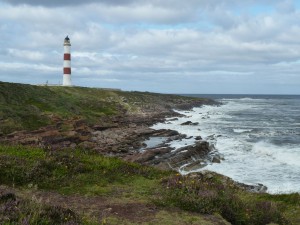 ness Seann Lochl., rubha
ness Seann Lochl., rubha
ann an Tarbat Ness (Rubha Thairbeirt),
sand Seann Lochl. sandr, gainmheach, agus
wick Seann Lochl. vik, bàgh
ann an Shandwick (Seannduaig), mapa aig Pont ‘Sandwyck’ (c.1590), agus ‘s dòcha ann an Nigg (Neig) cuideachd, tro Ghàidhlig: vik > uig > an uig > a’ Nuig (ach v. Na Gàidheal mìos sa tighinn)
bay Seann Lochl. vagr > G. bàgh
A-staigh san tìre tha fianais Lochlannach anns na h-ainmean le
-bol Seann L. ból / bólstadr, tuathanas, tuineachadh
Arboll : Arkbo (mapa Pont c. 1590) ork-ból. ‘ark-stead’ no ‘seal-stead’ (Watson WJ 1976: 47)
Cadboll (Cathabol): Cattbo (mapa Pont c. 1590) kattar-ból , ‘cat-stead’ (Watson WJ 1976: 40),
– dal Seann L. dalr, gleann, srath
Bindal: bind-dalr, ‘sheaf-dale’ (Watson WJ 1976: 46),
Gean– Seann L. gja, mòr-bheàrn
Geanies: gja le cruth iolra Gàidhlig gàan > Gathenn
-eye Seann L. eith, leth-eilean no uisge eadar dà loch > G. uidh
Loch Eye (Loch na h-Uidhe): bha ‘uidh’ ann eadar Loch Eye agus loch eile, Loch Slinn, nach eil ann tuilleadh.
Ach tha a’ mhòrchuid de na h-ainmean-àite againn a’ tighinn bho Ghàidhlig, agus bidh sinn a ‘ sealltainn riuthasan an ath thuras.
*************************************************************************
Placenames of Easter Ross 1 – the Picts and the Vikings
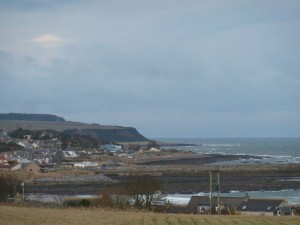 Although Easter Ross is not a large area, it has a very varied geography and a long and interesting history, and this is is well attested in the placenames that each people, and each generation, left on the map. We can follow this on old and new maps (like Pont’s map of c. 1590, and OS maps), in written resources (such as WJ Watson’s Place names of Ross and Cromarty, 1904), and in information from the inhabitants themselves.
Although Easter Ross is not a large area, it has a very varied geography and a long and interesting history, and this is is well attested in the placenames that each people, and each generation, left on the map. We can follow this on old and new maps (like Pont’s map of c. 1590, and OS maps), in written resources (such as WJ Watson’s Place names of Ross and Cromarty, 1904), and in information from the inhabitants themselves.
I’ll be looking at these peoples and their languages in the next few articles. Any comments or further information very welcome.
The Picts
Although we know from the Roman geographer Ptolemy about the Decantae, a tribe who were established in Easter Ross around 120 AD, there are no placenames which can definitely be attributed to them. The Picts were the next people who appear in accounts of the area, mentioned by the Romans and in writings about St Columba. They were living in the North and the East of Scotland from the 3rd to the 9th century. Pictish remains are thick on the ground in Easter Ross, with the massive carved standing stones of Nigg, Shandwick and Hilton (c. 7th – 9th centuries), and the site of the Pictish monastery at Portmahomack.
But although we don’t have any Pictish writings, it’s not just the standing stones that they have left us. There is one basic element in Easter Ross placenames which is a sure sign that there were Pictish settlements here:
Pit – a portion of land, town, settlement.
We see it in Pitkerrie, Pitcalnie, Pitcalzean, Pitnellies, Pithogarty, Pitmaduthy etc
(The other part of the name is usually of later Gaelic origin – more in the next article.)
There is also the placename Petley, but this is unrelated – it’s a modern personal name.
The Vikings
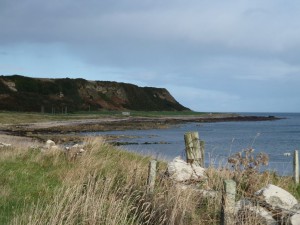 The area also has a Viking heritage. There’s archaeological evidence from Tarbat, in the sacked Pictish monastery site, that they didn’t always come in peace, but it’s very clear in the placenames that there were Norse settlements in Easter Ross too. It’s likely that they lived side by side with the local population, the Picts and later the Gaels, as happened elsewhere. It’s rare that there are clean breaks between peoples, in any area.
The area also has a Viking heritage. There’s archaeological evidence from Tarbat, in the sacked Pictish monastery site, that they didn’t always come in peace, but it’s very clear in the placenames that there were Norse settlements in Easter Ross too. It’s likely that they lived side by side with the local population, the Picts and later the Gaels, as happened elsewhere. It’s rare that there are clean breaks between peoples, in any area.
With the Vikings being such reknowned seafarers, it’s small wonder that there are coastal names with basic elements such as:
ness Old Norse, point
> Tarbat Ness
sand Old Norse. sandr, sand, and
wick Old Norse. vik, bay
> Shandwick, ‘Sandwyck’ on Pont’s map (c.1590), and possibly in Nigg too, via Gaelic: vik > uig > an uig > ‘a Nuig’
bay Old Norse. vagr > bay
(So Shandwick Bay actually means Sand Bay Bay!)
Inland there is also evidence of the Viking settlers in names with:
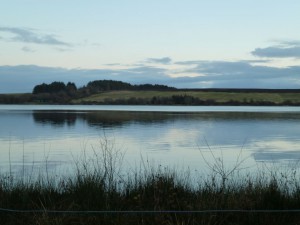 -bol Old Norse ból / bólstadr, farmstead
-bol Old Norse ból / bólstadr, farmstead
> Arboll (Arkbo on Pont’s map c.1590): ork-ból. ‘ark-stead’ or ‘seal-stead’ (Watson WJ 1976: 47)
Cadboll (Cattbo on Pont): kattar-ból , ‘cat-stead’ (Watson WJ 1976: 40),
– dal Old Norse dalr, glen, strath
> Bindal: bind-dalr, ‘sheaf-dale’ (Watson WJ 1976: 46),
Gean– Old Norse. gja, chasm
> Geanies
–eye Old Norse eith, peninsula or ‘water between two lochs’ (> Gaelic uidh, step, stage)
> Loch Eye (Loch na h-Uidhe): there apparently used to be a ‘step’ of water between Loch Eye and the long gone Loch Slin.
But the majority of Easter Ross placenames come from Gaelic, and we’ll be looking at some of those the next time.
Aithris-bhideo mu Sheapail Ghàidhlig eachdraidheal Chrombaidh. Tha iad an sàs ann an stèidheachadh urrais is iad an dòchas airgead a thogail gus nach bi i a’ tuiteam às a chèile. Suideachadh coltach ri seann seapail eile anns an Eilean Dubh, Eaglais Chille Mhìcheil. Gur math a thèid leis an dithis aca.
http://www.bbc.co.uk/naidheachdan/21260302
Video-report about Cromarty’s historic Gaelic Chapel. They are in the process of forming a trust in the hope of raising money to stop it falling apart – a situation silimilar to another old Black Isle chapel, Old Kirkmichael. Good luck to both of them.
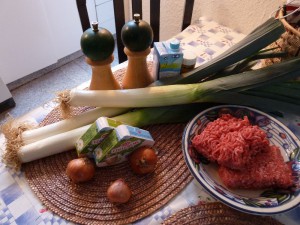 Brot creamh-gàrraidh le mions is càise
Brot creamh-gàrraidh le mions is càise
Seo reasabaidh Gearmailteach dhuibh a fhuair mi bho mo charaid Inge à Bonn. Bha mi air cèilidh oirre aon nochd-gheamhraidh fhuar an-uiridh agus bha am brot seo na deagh shiupear às dèidh latha fhada agus slighe sgìtheil, cho blasta ‘s cho teth gun do dh’fhuirich e nam chuimhne. Agus a-nis, far a bheil na làithean geamhraidh againn a-rithist, thàinig e a-steach orm gum bu chòir dhomh feuchainn ri a dhèanamh mi-fhìn.
Gritheidean (4 pòrsanan matha)
500gr. mions mairt-fheòil
3 creamhan-gàrraidh meadhanach
1 uinnean
700 ml. sùgh-glàsraich
100 – 150 gr. càise giullaichte simplidh
100 – 150 gr. càise giullaichte le lusan
(Na cleachd càise bog nàdarra. Bidh e a’ binndeachadh!)
salann, piobar dubh, cnò-mheannt sgrìobte, beagan uachdair
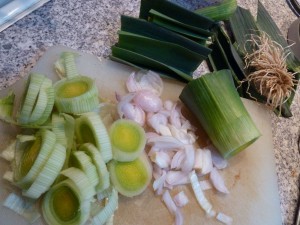 Cuir am mions beag air bheag ann am pana trom gun ola, agus feuch am bi e a’ fàs donn agus sgaoilte, gun chnapan, mar chriomagan.
Cuir am mions beag air bheag ann am pana trom gun ola, agus feuch am bi e a’ fàs donn agus sgaoilte, gun chnapan, mar chriomagan.
Anns an eadar-àm, geàrr na creamhan nan slìseagan agus an t-uinnean na phìosan beaga.
Cuir iad ris a’ mhions, fuirich mionaid no dhà gus am bi an t-uinnean glainneach soilleir, agus cuir an sùgh, an salann, gu leòr de phiobar, agus a’ chnò-mheannt ris.
Bruich air a shocair e gus am bi an creamh-gàrraidh bog, mu 20 mionaid, agus cuir an càise ris na phìosan beaga.
Cuir mun cuairt a h-uile rud gus am bi an càise air leaghadh.
Cuir làn na lèigh anns gach soitheach agus làn spàine uachdair air, ma thogras tu.
– Deiseil!
Ith le aran cruasbach e.
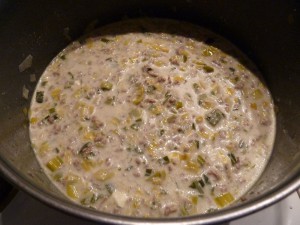 Tips:
Tips:
– Ma bhios tu ag ullachadh a’ bhrota ro làimh, na cuir an càise ris gus am bi thu ga ath-bhlàthachadh.
– Mura cuir thu uiread de shùgh ann, faodaidh tu am brot a chleachdadh mar shabhs le pasta no bùntata pronn.
– Le uireadan dùbailte tha am brot glè fhreagarrach do thachartasan leithid chèilidhean – faodaidh tu dìreach barrachd sùgh-ghlasraich a cuir ris mur a h-eil gu leòr ann….
****************************************************************
Leek soup with mince and cheese
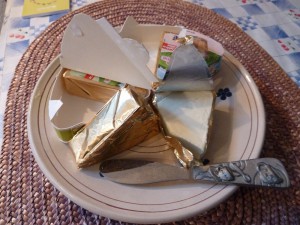 Here’s a German recipe for you that I got from my friend Inge from Bonn. I was visiting her one cold winter’s night last year, and this soup made a great supper after a long day and a tiring jouney, so tasty and warming that it stayed in my memory. And now that the winter days are upon us again, it ocurred to me that I should try to make it myself.
Here’s a German recipe for you that I got from my friend Inge from Bonn. I was visiting her one cold winter’s night last year, and this soup made a great supper after a long day and a tiring jouney, so tasty and warming that it stayed in my memory. And now that the winter days are upon us again, it ocurred to me that I should try to make it myself.
Ingredients (4 good-sized portions)
500 gr. beef mince
3 medium leeks
1 onion
700 ml. vegetable stock
100 – 150 gr. plain soft processed cheese (like Dairylea)
100 – 150 gr. soft processed cheese with herbs
(Don’t use fresh soft cheese or it’ll curdle!)
salt, black pepper, grated nutmeg, a little cream to garnish
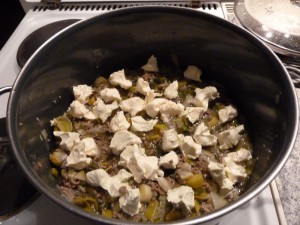 Put the mince bit by bit into a heavy pan to brown, without oil. Keep it loose, without lumps, like crumbs.
Put the mince bit by bit into a heavy pan to brown, without oil. Keep it loose, without lumps, like crumbs.
Meanwhile slice the leeks and chop the onion.
Add them to the mince, wait a few minutes till the onion turns clear and glassy, then add the stock, the salt, plenty of pepper, and the nutmeg.
Simmer till the leek is soft, about 20 minutes, then add the cheese in little chunks.
Stir it all until the cheese has melted.
Put a ladleful in each bowl and optionally a spoonful of cream on top as garnish.
Ready!
Eat with crusty bread.
Tips:
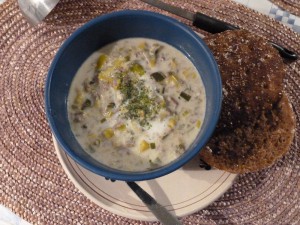 – If you’re making the soup in advance, only add the cheese before you warm it up.
– If you’re making the soup in advance, only add the cheese before you warm it up.
– If you don’t put in as much stock, you can use the soup as a sauce with pasta or mashed potato.
– With double quantities the soup is perfect for events like parties – you can just add more stock if there’s not enough soup to go round…

